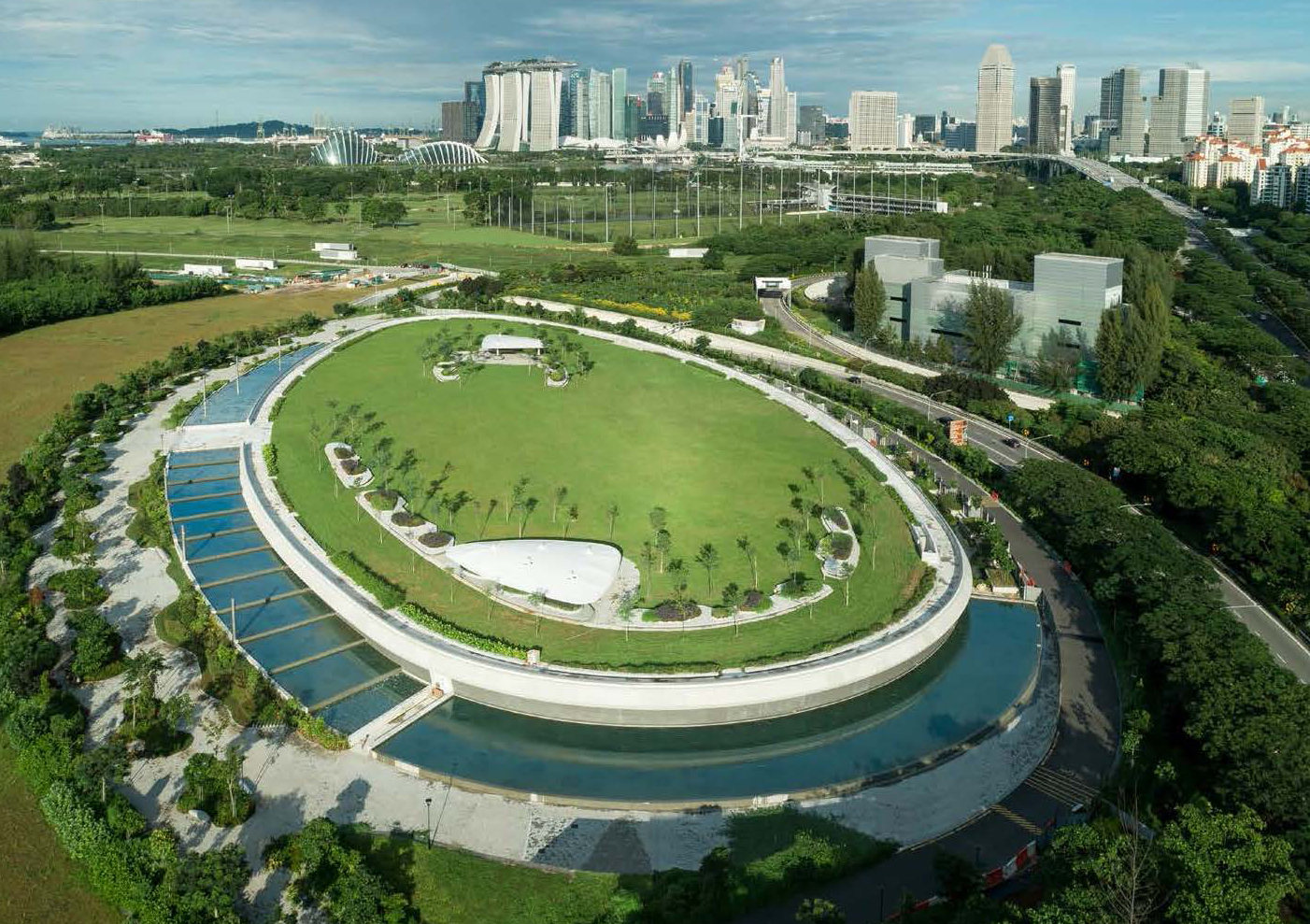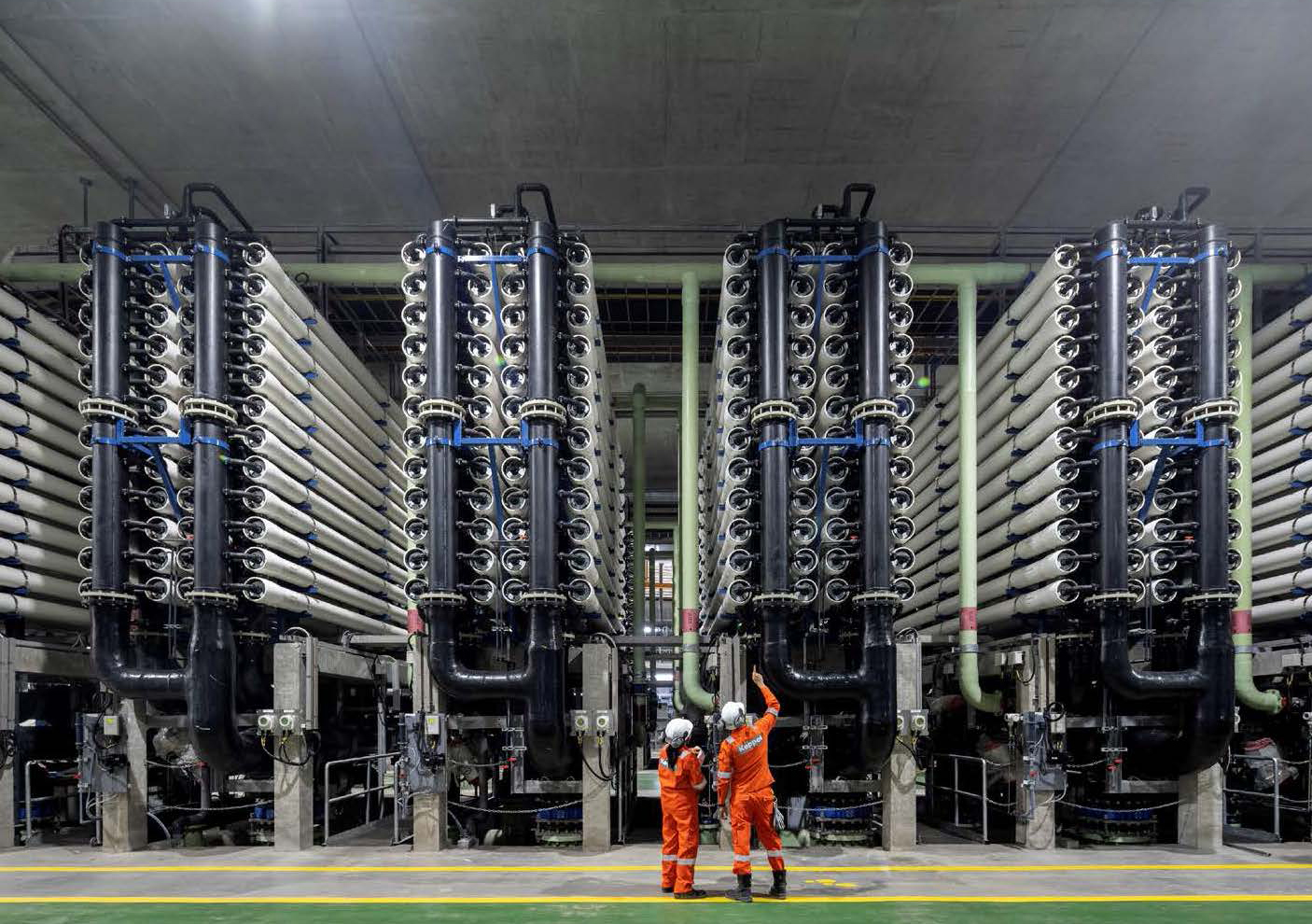In its latest bid to improve the resilience of its water supplies, Singapore’s national water agency — the Public Utilities Board — officially opened the 137,000 cu m/day Keppel Marina East Desalination Plant in February. The facility is entirely underground, with a publicly accessible park located atop it.
Singapore's fourth desalination facility, the new treatment plant is also the island city-state’s first large-scale dual-mode desalination facility, meaning that it can treat freshwater and seawater. This dual capability facilitates PUB’s ongoing efforts to diversify the water supplies for the densely populated but water-limited nation.

The four taps
Singapore’s potable water supply comes from four sources, or “taps,” as PUB refers to them: rainfall from local catchments, imported water, desalination, and recycled water, which is known locally as NEWater. “Local catchment and imported water constitutes more than half of our water demand,” according to a statement provided by PUB. “NEWater (recycled water) and desalinated water are weather-resilient sources that help strengthen our water security. Together, the Four National Taps ensure diversified water supply sources for Singapore.”
Of the four taps, only desalinated water is a “practically limitless source,” said PUB CEO Joo Hee Ng in a Feb. 4 news release. “It is also weather-resistant and always available, rain or shine, as a source of life-giving water,” Ng said. “The availability of desalination makes Singapore’s water supply immensely resilient. And the KMEDP coming online further strengthens Singapore’s water security.”
In recent years, PUB has worked to decrease its reliance on imported water by taking steps to increase the capture of rainfall in local catchments and construct recycled water facilities and desalination plants. For example, the KMEDP is located near the Marina Channel, a local waterway that empties into the Singapore Strait.
In 2008, PUB completed work on the Marina Barrage, a dam constructed at the mouth of the channel to prevent seawater from entering. Over time, rainfall naturally converted the once-brackish water into a freshwater reservoir, known as the Marina Reservoir. It is this reservoir that the new KMEDP draws from when freshwater is to be treated at the plant.
Dual mode
A dual intake enables the facility to accept either seawater or freshwater. “Depending on the prevailing weather conditions, water is channeled from either the Marina Reservoir or the sea to the KMEDP,” according to PUB’s statement. During periods of dry weather, the facility will take in and treat seawater. During the rainy season, the plant will treat freshwater from the reservoir.
“Having this dual-mode capability … affords PUB greater operational flexibility, as producing desalinated water is more energy-intensive,” PUB’s statement notes.
The KMEDP was designed and built by Keppel Infrastructure Holdings Pte Ltd., which is a wholly owned subsidiary of Keppel Corporation Limited, a Singapore-based entity that focuses on energy and the environment, urban development, connectivity, and asset management. The facility will be operated until 2045 by Marina East Water Pte Ltd., a wholly owned subsidiary of Keppel Infrastructure.

The facility’s treatment train includes a dissolved-air flotation system to remove such contaminants as oil, algae, and suspended solids from the feed water. Flows then pass through a microstrainer system that removes particles having diameters of more than 100 µm. The subsequent ultrafiltration system uses membranes with pore sizes of 0.02 µm to remove viruses, bacteria, and chlorine-resistant microorganisms. Next, the reverse-osmosis system removes ions and dissolved solids from the water, which then undergoes disinfection by means of ultraviolet light. Minerals are added to the treated water before it enters PUB’s distribution system.
Increased efficiency
Because of the energy-intensive nature of desalination, the new facility includes certain measures designed to reduce overall energy demand. For example, the new desalination plant includes the “energy-efficient direct coupling” of the ultrafiltration and reverse-osmosis systems, according to the news release.
As a result of this method, water that is filtered from the upstream ultrafiltration process is “fed directly to the downstream (reverse-osmosis) process, eliminating intermediate break tanks and pumping stages, resulting in significant cost and space saving, and (making) the process up to 15% more energy-efficient,” the release states.
The reverse-osmosis treatment process differs slightly, depending on whether the facility is treating seawater or reservoir water. Because of its higher dissolved solids content, seawater treated by the facility undergoes an initial process involving higher pressures than those used to treat reservoir water, according to a statement provided by Keppel. Known as the seawater reverse-osmosis system, this membrane unit is “equipped with a high-efficiency energy-recovery system, reducing the overall power consumption of the plant,” the statement notes.
Permeate from the seawater reverse-osmosis system then enters the subsequent, lower-pressure system used to treat reservoir water. When the plant is treating reservoir water, the lower-pressure system receives a direct feed from the ultrafiltration filtrate, bypassing the higher-pressure reverse-osmosis membrane unit.
To conserve space and provide a parklike setting in heavily urban Singapore, the plant’s treatment facilities are located below-ground, enclosed by nearly 20,000 sq m of publicly accessible rooftop space that is covered in grass and other vegetation.
“By designing the plant completely underground, a more compact footprint was achieved, freeing up land above for other use,” according to Keppel’s statement. “This is especially important in land-scarce Singapore.”




